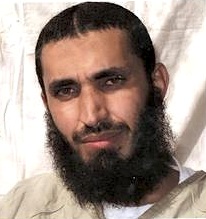|
By Andy Worthington
From Andyworthington.co.uk | Original Article

Last Wednesday, Abd al-Malik Wahab al-Rahabi (aka Abdel Malik Wahab al-Rahabi), a Yemeni prisoner held at Guantánamo since the day the prison opened on January 11, 2002, became the 690th prisoner to be released, when he was given a new home in Montenegro. He was the second prisoner to be resettled in the Balkan nation, following another Yemeni in January.
Al-Rahabi is also the 10th prisoner to be freed after being approved for release by a Periodic Review Board, a review process set up in 2013 to review the cases of men described as “too dangerous to release” or recommended for prosecution by the previous review process, the Guantánamo Review Task Force that President Obama established shortly after taking office in January 2009. 36 decisions have been taken to date, and two-thirds of those — 24 — have ended up with recommendations for release, a rather damning indictment of the task force’s extreme caution and/or mistaken analyses of the prisoners’ significance.
The task force described 48 men as “too dangerous to release,” despite conceding that there was insufficient evidence to put them on trial (which, in other words, was not evidence at all, but a collection of dubious statements made by the prisoners themselves), and the men recommended for prosecution has their proposed charges dropped after appeals court judges, embarrassingly, threw out some of the few convictions secured in Guantánamo’s permanently troubled military commission trial system, because the war crimes for which they had been convicted had been invented by Congress.
Al-Rahabi’s case was first reviewed on January 28, 2014, and he was approved for ongoing detention on March 5, 2014, but when his case was reviewed again, on November 5, 2014 (see documents here), he was approved for release. This was on December 5, 2014, but he has languished at Guantánamo ever since. See my definitive Periodic Review Board list for all the other prisoners approved for release but, sadly, still held, although the Obama administration has promised to release them by the end of summer — along with the 15 other prisoners approved for release by the task force in its final report in January 2010.
Reporting on al-Rahabi’s release, Carol Rosenberg of the Miami Herald explained that the government of Montenegro issued a statement that it took in al-Rahabi as a humanitarian gesture, and that both he and the man freed in January — Abdul Aziz al-Suadi — “were applicants for asylum at no cost to ‘Montenegrin taxpayers.’” The statement added that both men “will eventually be free to choose the country they want to live in.”
The US government will not repatriate Yemeni prisoners, because of security fears about their homeland, and, when al-Rahabi was approved for release, the review board “recommended that he be sent to a country where his wife and now teenaged daughter could join him,” as the Miami Herald put it.
His attorney, David Remes, said, “He’s been waiting for 14 years to reunite with his wife and the daughter he’s never met. We are glad he’s been released at last.”
Remes added that al-Rahabi “has seen his daughter, Aisha, in occasional Skype video chats in his years at Guantánamo but last saw her in person when she was three months old in 2001.”
Al-Rahabi, who was regarded as one of the “Dirty Thirty,” a group of men dubiously described as Al-Qaeda bodyguards, had been “a committed hunger striker during the 2013 protests, so much so that Navy medics kept him on a force-feeding list,” as the Miami Herald described it.
With al-Rahabi’s release, 79 men are left at Guantánamo — the 29 approved for release, mentioned above, just ten facing, or having faced trials, and 40 others awaiting PRBs or the results of PRBs.
|